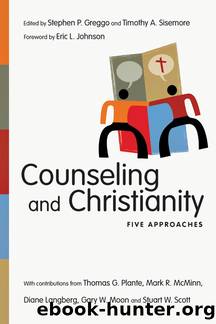Counseling and Christianity by Greggo Stephen P.;Sisemore Timothy A.;Johnson Eric L.;

Author:Greggo, Stephen P.;Sisemore, Timothy A.;Johnson, Eric L.; [Greggo, Stephen P.]
Language: eng
Format: epub
Publisher: InterVarsity Press
Published: 2012-08-01T00:00:00+00:00
Figure 6.1. Willardâs Model of the Person
In this model (see figure 6.1), we are presented with not only the components of the person but also the only five things a human being can do. Humans can think, feel, behave, interact with others and choose. The spirit/will/heart is the center or core of a personâs life and may be called the âegoââespecially when functioning separately and apart from God as the source of life.[8] âChoiceâ is perhaps the best one-word encapsulation for the activity of this spirit/will/heart dimension. It underscores the most fundamental decision faced by humanity. Like their forebears, Christians, I believe, awaken each day to the choice of living in an intimate, conversational and communal relationship with God, or of initiating and maintaining a separate existence. The critical decision for the spirit/will/heart (or CEO of the person) is between willingness, surrender and obedience versus willfulness, autonomy and separation from the Source of life.
According to Willard, the soul, as distinguished from the spirit/will/heart, can be viewed as the invisible computer that keeps everything running and integrated into one person. The soul is the aspect that integrates all of the components of the person to form one life. The soul, Willard pens, âis that aspect of your whole being that correlates, integrates, and enlivens everything going on in the various dimensions of the self. It is the life-center of the human beingâ (Willard, 2002, p. 199).
Willardâs model of human functioning provides a holistic way of conceptualizing and working with individuals that easily embraces abnormal psychology, positive psychology and the soul/spirit. That is to say, each component (think âcognitiveâ aspect as one illustration) can be focused on for the purpose of (1) improving maladaptive functioning (e.g., reframing and restructuring thought patterns that lead to negative outcomes); (2) increasing positive outcomes (e.g., strengthening and enhancing existing thought patterns that support positive functioning); and (3) enhancing Christian spiritual formation (e.g., examining an individualâs views and concepts of God for the purpose of facilitating the process of learning to live more moments âwithâ God). Now, that is a psychology that excites me, and it is certainly one that informs my application of a transformational psychology.
Jesus is very smart. For most of my professional career I created a hierarchy of value for the various âschoolsâ of psychology based on how closely they resembled the natural sciences. Neuropsychology and the biological explanations of behavior were at the top, closely followed by behavioral and cognitive approaches. I gave some credence to person-centered approaches as a safe way to spend time with clients before the âreal psychologyâ could be brought in, and I tolerated the existence of Freudian approaches in a manner similar to the way I would tolerate a beloved, senile grandparent.
At the same time, I came to accept the Western view that the term knowledge should be reserved for subjects like math and the natural sciences. Religionâeven Christianityâdealt in matters of faith, belief and profession, but not knowledge. Indeed, how could one make a âleap of faithâ
Download
This site does not store any files on its server. We only index and link to content provided by other sites. Please contact the content providers to delete copyright contents if any and email us, we'll remove relevant links or contents immediately.
The Art of Thinking Clearly by Rolf Dobelli(8902)
The 5 Love Languages: The Secret to Love That Lasts by Gary Chapman(8576)
Mindhunter: Inside the FBI's Elite Serial Crime Unit by John E. Douglas & Mark Olshaker(7877)
Becoming Supernatural by Dr. Joe Dispenza(7144)
The Road Less Traveled by M. Scott Peck(6672)
Nudge - Improving Decisions about Health, Wealth, and Happiness by Thaler Sunstein(6669)
Enlightenment Now: The Case for Reason, Science, Humanism, and Progress by Steven Pinker(6436)
Win Bigly by Scott Adams(6345)
Mastermind: How to Think Like Sherlock Holmes by Maria Konnikova(6280)
The Way of Zen by Alan W. Watts(5830)
Factfulness: Ten Reasons We're Wrong About the World – and Why Things Are Better Than You Think by Hans Rosling(4045)
The State of Affairs by Esther Perel(3966)
Gerald's Game by Stephen King(3949)
Man's Search for Meaning by Viktor Frankl(3677)
The Confidence Code by Katty Kay(3599)
Thinking in Bets by Annie Duke(3557)
The Worm at the Core by Sheldon Solomon(2947)
Enlightenment Now by Steven Pinker(2934)
Liar's Poker by Michael Lewis(2834)
